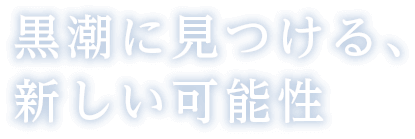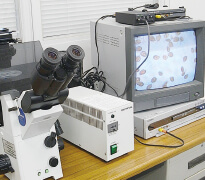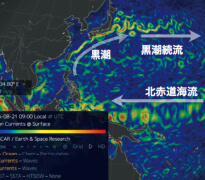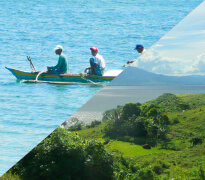

The Kuroshio is the western boundary current of the North Pacific Gyre. Our goal of the "4D-Kuroshio Project" is to make an innovation and renovation of marine resource sciences to realize the sustainable development of unutilized natural resources in the Kuroshio region, and also to establish educational chain promoting the sustainability. We are going to understand on the spatial and temporal variation of potential marine resources, such as marine mineral, microbial, and deep-water resources including with environmental change of Kuroshio region; 1) coastal to offshore crossing the Kuroshio (1st dimension), 2) variation of Kuroshio pathway (2nd dimension), 3) vertical profiles (3rd dimension) and 4) time variation from past to present (4th dimension).




The Kuroshio Current, which flows calmly through the Pacific Ocean, brings many tangible and intangible blessings to Kochi. At Kochi University, which is located near the Kuroshio Current sphere, we have continued to conduct education and research on the Kuroshio area at the Kuroshio Science Program, Graduate School of Integrated Arts and Sciences, which has its roots in 2004, and at the Department of Marine Resource Science, Faculty of Agriculture and Marine Science, which was newly reborn in 2016.
The Four-Dimensional Kuroshio Marine Science (4D-KMS) research project, which is a priority item during the third medium-term target period for the university, is a grand and cutting-edge research project that can only be conducted at Kochi University, and is open to researchers from within the university and around the world. The most significant feature of the project is that in addition to spatial expansion in three dimensions, it incorporates a time axis in a fourth dimension, so that points in the course of eternal history up until the formation of the Kuroshio Current sphere are viewed as subjects for research, and those results are utilized for integrated coastal and ocean management.
It is our hope that we can contribute to education and research in Japan and around the world by disseminating cutting-edge results, which are based on the concept of the integration of arts and sciences, through our worldwide network.
(March 2019) Kochi University President, Katsutoshi Sakurai

AY2020 is the fifth year of the Four-Dimensional Kuroshio Marine Science (4D-KMS) research project. This academic year, we clarified the relationship between the results achieved by each team over the past four years and the objectives of the overall program, and put together a summary of this program for the final academic year. We also began making preparations to publish a textbook on four-dimensional Kuroshio marine science, targeted at undergraduate and graduate students. On the other hand, some of our activities were constrained by the spread of COVID-19. Although Team I, “Promotion of Resource Research in Kuroshio Area,” was relatively unaffected, the team lost opportunities to collect data. As for Team II, “Systemization of Integrated Coastal and Ocean Management,” students from the first cohort in AY2016 who entered the Department of Marine Resource Science, Faculty of Agriculture and Marine Science in our university went on to enter the newly established Marine Resource Science Course, Agricultural and Marine Science Program, and took their first steps as researchers. Amidst a situation where it was difficult to conduct in-person lectures, we were able to hold Introduction to Coastal and Ocean Resource Studies, a common course for the master’s programs, and the Integrated Coastal and Ocean Management (ICOM) education program, which is held at the undergraduate school, via online classes. On the other hand, for Team III, “Marine and Coastal Personnel Development and Regional Industry Creation,” although we moved forward with training personnel who grasp the concept of integrated coastal and ocean management—primarily targeted at international students from SE Asia in the doctoral program—we were unable to carry out some plans, such as the Leader Nurturing Program to Create a Sustainable Regional Society in Kuroshio Region, for this academic year. Among them, we had to cancel a ceremony to commemorate the establishment of an alumni association, mainly for graduates of our doctoral programs, that was scheduled to be held in the Philippines in August and attended by President Katsutoshi Sakurai and Director Hiroyuki Ukeda. We hope that COVID-19 will be settled in 2021, and that exchanges with foreign countries will resume.
We can cite a paper by Nagasaki et al, “Chronological distribution of dinoflagellate-infecting RNA virus in marine sediment core,” as an example of noteworthy research results from this academic year. This paper combines molecular microbiological detection and diversity analysis of viruses in piston core samples of seafloor mud—collected from Uranouchi Bay, Ura, Kochi Prefecture—with lead and cesium dating to reveal time variations in RNA viruses. This research result received acclaim as an extremely unique paper that analyzed time variations in viruses, and it was published in STOTEN, which has a high impact factor as an environment-related scientific journal.
In addition, we can cite research on the dating of deep-sea precious coral, conducted by Okumura et al, as a research result which is closely related to the local community. The 14C age of dead deep-sea precious coral specimen collected from off Ashizuri is older than 1871, the year that coral fishing began in this area, indicating that the coral colonies died due to natural conditions, not due to man-made disturbances. Since these research results are very valuable information for determining whether or not sustainable precious coral fishing is feasible, they were published in Radiocarbon.
The 2021 academic year is the final year to accomplish the objectives of this program. We hope to achieve the objectives of the program by making further progress with our research activities.
Project Leader (2018-2021), Hidekazu Tokuyama
